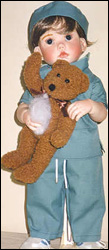Doll Making
Insider Info
If you think dolls are strictly for girls and grandmas, think again. These
figures can be anything from pudgy old men to frog-riding fairies. No matter
who you are, there's a doll out there to suit your taste.
In fact, many of these artists prefer to be called figurative sculptors
because of connotations associated with the word "doll."
Jean Lotz is a doll maker with her own studio. "There are many sculptors
who do not want the term 'doll' associated with their work in any way," she
says.
"Many modern figurative sculptures are indeed very far from the wholesome
play doll stereotype, and are rightfully targeted to an adult, art collector
customer base."
 |
| Doll makers use cloth, ceramics and many other different kinds of
materials to create unique sculptures. |
| Courtesy of: Carol Salmon |
For some companies, making dolls is a multimillion-dollar business. But
for the thousands of people who make dolls one at a time, it's an expression
of creativity.
Doll makers design and create their own dolls, from china dolls and cloth
gnomes to stuffed animals and historic figures. They usually work with cloth,
porcelain, or wood to create unique dolls -- and accessories such as furniture
and clothing.
They're creative thinkers who are good with their hands.
There are very few limits to the imagination, says Lotz. "Dolls and figures
are being made in every shape, size, style and medium. You just need to start
browsing doll artist sites on the Net to get a glimpse at the potential for
creativity!"
Lotz carves one-of-a-kind basswood dolls from scratch, many of which are
now privately owned by serious collectors.
There are several areas within the doll field. Some artists sculpt or carve
unique dolls from scratch. Some make dolls from existing molds, while others
reproduce and restore antique dolls. Costume design is another specialty within
the field.
Many doll makers even go on to teach, write and research about dolls and
doll making.
Doll makers often gather in groups to exchange ideas and offer encouragement
to one another, just as artists and writers often do. As Lotz points out,
doll making is an art that transcends cultural and geographical boundaries
-- anyone can participate.
"The doll business is a very unique, flexible field and it can suit many
different people -- people of all ages, races, sexes and religions all over
the world," she says.
Like all serious artists, doll makers date and sign each piece. They also
keep careful inventory of their work by recording dates and titles and by
keeping photographs of each doll.
Most doll makers also design clothes from a variety of fabrics, and use
real human hair or a substitute to make wigs for their dolls. Those who work
with porcelain are usually adept with paint so they can design and apply faces.
A working knowledge of human proportions is helpful. Did you know, for
example, that your eyes are exactly halfway between the top and bottom of
your face? While many doll makers make distorted and funny characters, some
strive for a more realistic look.
Women outnumber men in the field. In the past, however, it was more balanced.
Cody Goodin makes healing dolls based on native American tradition, although
he says he uses many sources as inspiration. "Men, actually, were quite common
in the doll making field in the early days. It was only in [Canada and the
U.S.] that doll making was looked upon as a woman's craft," he says.
"There are plenty of men in the sculpted doll field. But I think I am in
a minority as far as cloth doll makers go. I would certainly like to see more
men get into the field. The more the merrier!"
Getting Started
Getting started takes a small investment. A basic cloth doll requires needle
and thread, a stuffed doll body, and some additional cloth -- an investment
of about $20.
For artists who use porcelain -- which is sculpted and then fired in an
oven (called a kiln) -- the cost per doll can reach $65 or more. Seasoned
pros often charge over $1,000 per doll.
The hobby can become a business. Doll makers usually begin by selling a
few dolls at local craft sales, covering time and expenses, and earning a
few dollars per doll. After a little experience and exposure, some choose
to mass-produce their product or sell it through retail and wholesale venues.
Others sell their designs to manufacturers.
Learning to make dolls is usually a matter of some training, lots of practice
and some trial and error.
"Doll making is an art form that requires a certain amount of skill and
dedication," says Goodin. "It takes many attempts to...achieve an acceptable
result."
Doll-making lessons are available through some continuing education programs.
As well, there are dozens of books, videos and Web sites that detail the steps
of doll making.
"The Internet is currently changing the face of the doll industry," says
Lotz.
"More and more artists are choosing to sell their work via virtual means
rather than attending the traditional style doll shows because the Net provides
ways to display our work to a broader audience with no travel expense."
She adds, with emphasis, that the market is tough for people trying to
make money in the doll field. "This is not a field to make money fast and
furious with minimal effort. Doll artists have to constantly strive to improve
their product, and strive to create a market for their product."
Associations
National Institute of American Doll Makers
E-mail
:
niada@niada.org
Internet
:
http://www.niada.org
Links
Sew Sweet
Complete with stories on how many experts got started
Loved to Pieces Doll Hospital
Make an appointment for your doll with Doctor Karen
Bell Ceramics
World's largest doll-making supplies company
Back to Career Cluster